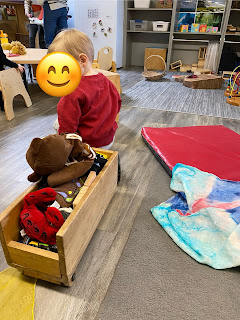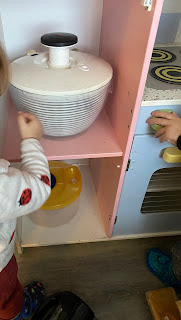This is a Pedagogical Narration, also known as a Learning Story. It is the process of noticing and collecting moments from daily practice and sharing these with colleagues, children and families to make children's learning processes and inquiries as well as educator's pedagogical choices visible and open to interpretation and reflection.
Simply put, pedagogical narration may be thought of this way:
Listen deeply
Be curious
Embrace wonder
Share the story
Early Learning Framework, p.51
Here is the story of a little boy in our infant and toddler room.
I become aware of it slowly but surely. I watch, and see repetition in his play. I watch some more to be sure. I am intrigued, yes, he has caught my attention.
He is sitting on the wooden tractor, his legs pumping up and down, propelling it forward. He circles around the room with the trailer loaded to the brim behind him.
Everyday, for many days I have seen him driving around the room with his load. The load is different from day to day. The play is similar.

A loaded trailer.
And again.
And again.
A transporting schema. And an overlapping positioning schema. That's what I think might be happening in his play. I check in with my co-workers to see and hear what they think. We talk about Schemas, what they are and why children use schemas in their play. We would like to learn more about Schemas so I borrow some books.
Jean Piaget (1896-1980), a Swiss Psychologist, known for his work on child development, described a Schema as "a thread of thought that is demonstrated by repeated pattern's in children's play, meaning that children's play is a reflection of deeper internally and specifically directed thoughts. When children are exploring schemas, they are building understanding or abstract ideas, patterns and concepts."
I like how Alexis Ralphs describes a schema in his blog, onehundredtoys.com.
"Schemas are mental models. They are representations we have in our minds of how objects move, for how they can be connected and transformed. In fact, there is no end to the ways we can conceptualize the world, but we tend to group them into around a dozen main categories, positioning and transporting are a few of these."
I learn that there are about ten common schemas but there could be up to forty. Children engage in schema play daily. As educators, we can observe their play and learn along side them by providing materials and experiences that might support their interests and needs.
Transporting: Picking things up, moving them, and putting them down or dumping them.
Positioning and Ordering: A desire and drive to line items up and position objects in space, like sorting things by category or stacking them one on top of the other.
Every day for many days now, he loads his tractor.
I realize, as I think about it, that I have been seeing him do this for several weeks at least. But I've only really noticed when the trailer is full.
As I watch him, I begin to wonder about a few things such as how does he pick what he wants to transport? Where is he going? What seems important about what he is learning?
I continue to observe. I begin to work harder at noticing the beginning and end of his play. In a busy toddler room its challenging to stay in one spot for an extended length of time because other little ones need you, so I ask my co-workers for support so I could focus on him. I also ask them to contribute their observations as we collaboratively observe his play.
He keeps at it, day by day and I keep watching. I see him circling the room on his tractor and picking up items from each area. He takes food items from the kitchen, or animals from where they are set up, cars from where they are set up near the car ramp. Are these things he likes? Or are they random items? He tosses a book in the back after he notices it has an ambulance on it. He has a toy ambulance in the back of his trailer. "Same, same", he says, as he shows me both.
I begin to notice how he loads items and that's when I see the positioning schema that he is incorporating into his play.
See how carefully he places the houses in the back. Some things are randomly loaded and some form a pattern.
The cars are carefully placed in a pattern.
He uses these covered blocks over the course of many days. I begin to notice that he picks ones that fit nicely together in the back. I realize as I think about the last couple of weeks of this play that he has been practicing and experimenting with some items repetitively. The blocks are one of these items.
The three smaller penguins fit in the back together and the bigger one sits in the front with him.
Here is an interesting way that he uses the positioning schema with the wood pieces. He loads the back with random shaped pieces of wood and notices some gaps where he can stand up some of these longer bits.
Loading and them immediately unloading. And then re-loading using a different method.
Part of transporting, logically, is going from A to B. Sometimes I will ask him as he drives his loaded tractor and trailer around the room, "Where are you going?" He usually doesn't say, but will look at me with a big smile on his face. I wonder what that smile means? It seems to me that he is happy doing what he is doing. I wonder if actually going somewhere isn't the important part of his play or perhaps it means he will find out when he gets there.
He usually takes his load of items somewhere in the room and unloads them. This load of wood however, is loaded and unloaded in the same place. As he unloads he makes a "zzzzzt" sound as each piece of wood is dropped out.
One day, I have a chance to talk to his mom about what I am seeing in his play. She tells me that when he was between 12 and 18 months, he watched his Grandpa build their house. I wonder if he saw vehicles loaded with materials coming to his house and dropping things off. I wonder if he is now building on that previously gained knowledge.
These blocks get unloaded onto this shelf.
We find one load left here.
And a load of books is piled here.
I notice him experimenting with oversized loads also.
An oversized floor seat.
Some oversized blocks.
And an oversized bead maze.
I am astounded at all the ways he thinks of using materials in the room. I chuckle to myself in amazement because of his persistence and commitment to learning. I'm glad we try to offer a space for children to play in where they are free to use materials how they need to and can move them around from place to place.
I find it interesting to see all the ways he has been challenging himself. At times I have heard screams or cries of frustration when an item doesn't fit the way he wants it to. I have also heard protesting sounds if another child gets too close to the tractor or tries to take something out of the back.
As I continue to watch him day by day I see him becoming more proficient in loading the white blocks just so, positioning them in the way that he is practicing. I also see him beginning to allow friends to interact with his play. I support these interactions by giving ideas of words that can be used to communicate his needs. I realize he is screaming less. Is he more confident in his play and more familiar with the outcome because he repeats the narrative in some form, daily?
He accepts the block from a friend and inserts it into the trailer. I wonder what his younger friend is thinking and learning from being able to participate in this play.
In this case, he not only allows friends to help load the trailer with books, he actually asks them to help him unload, saying, "L, I need help, there's too many books". They look around together to find a place to unload and choose the couch. I recently heard a TED talk where the speaker was explaining how we use words to transmit thoughts. I wonder if his actions (repetitive play) and his words that transmit his thoughts are now leading into collaborative play.
I have learned that it is important to continue to have a variety of loose parts available in our room for him to load. I wonder if we can add in any other transporting materials. He primarily uses the tractor and trailer, but will also load up a back pack and wear that while riding the tractor. What other items could we put out for him to explore?
"To enter into a style of teaching which is based on questioning what we're doing and why, on listening to children, on thinking about how theory is translated into practice and how practice informs theory, is to enter into a way of working where professional development takes place day after day in the classroom."
Sophia Shoptauph
I'm interested to see what he will do tomorrow and tomorrow after that. I will continue to observe and learn alongside him.
%20arya%202.jpg)
%20arya%201.jpg)
%20arya%203.jpg)
%20arya%206.jpg)
%20arya%205.jpg)
%20arya7.jpg)
%20arya%208.jpg)
%20arya%209.jpg)
%20aryA12.jpg)
%20arya%2010.jpg)
%20arya%2013.jpg)
%20arya%2014.jpg)

%20arya%2016.jpg)

%20arya%2018.jpg)










%20transporting%203.jpg)



%20blocks%20positioning.jpg)










%20myles%202.jpg)













